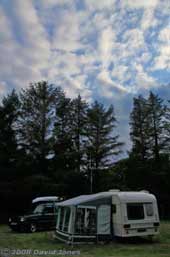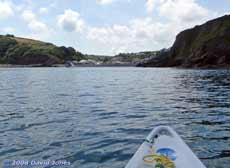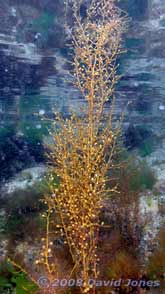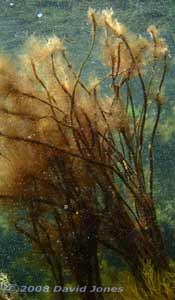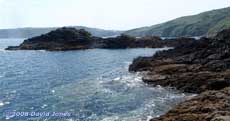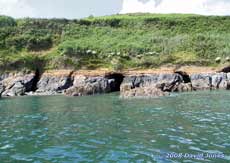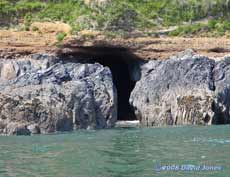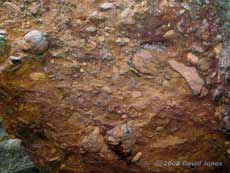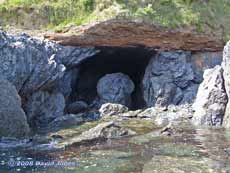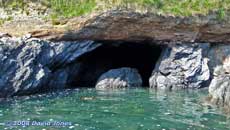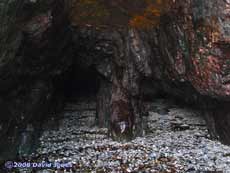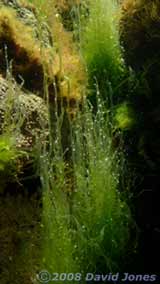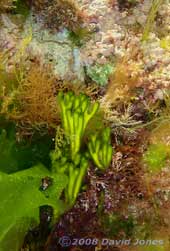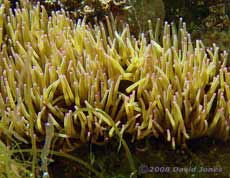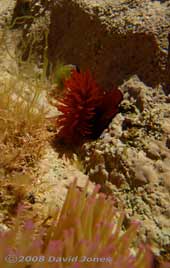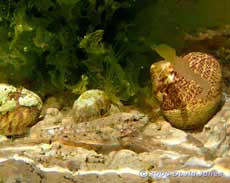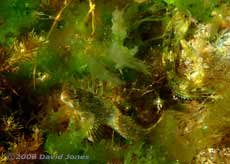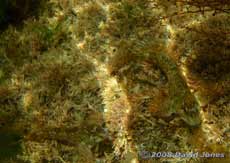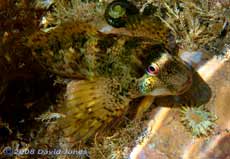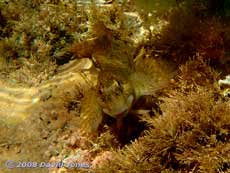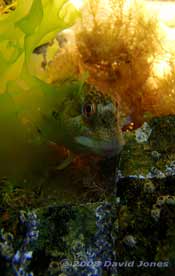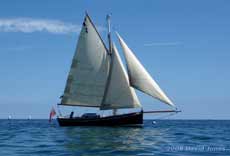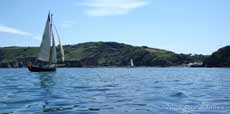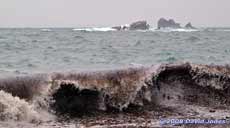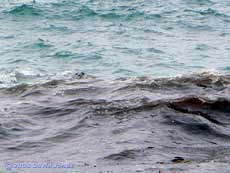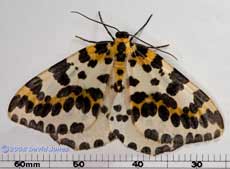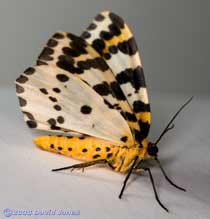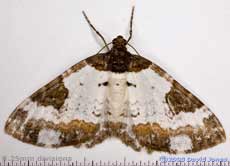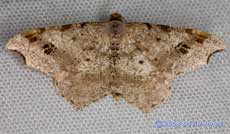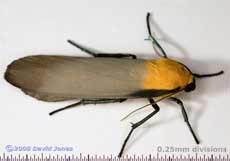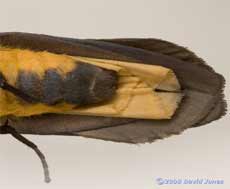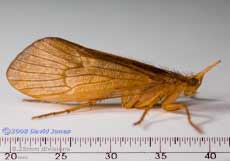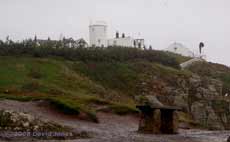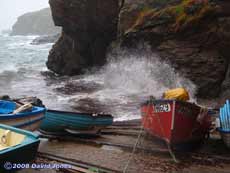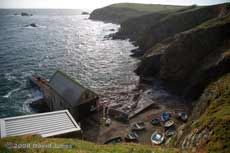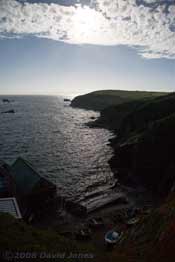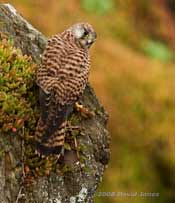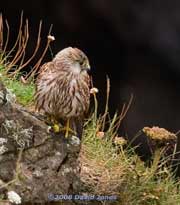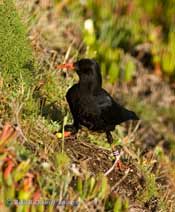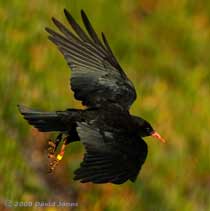Go to the last entry on this page .....Go to previous entry
We came down on the 24th, and the first few days of the holiday were just about perfect, with blue skies, calm seas and the irresistible temptation to get out onto the waters off Porthallow and relax on my sit-on-top kayak. These kayaks seem to be increasingly popular. Yesterday I saw more that ever before being used, mostly by people going fishing, usually with rods, although one chap turned up complete with camouflaged wetsuit and spear gun! As for me, I don't take fishing gear, although I sometimes take out a net and container to investigate the patches of floating seaweed.
One of my frustrations when using the kayak has been that when I see something interesting I haven't been able to share it with Sheila very easily, as she stays firmly on dry land. I do have a Canon underwater film camera which works well, but along with it came the need to finish the film, drive to the nearest town (Helston), wait for it to be processed etc. Apart from the fact that it meant that it was usually at least a few days before Sheila could see what I had seen, it also meant that trip to Helston which we usually avoid making (nothing wrong with Helston, it's just that we try to stay on the Lizard and shop locally!). Anyway, just before we came away I decided to fall into the trap of letting a TV ad convince me to buy something - I added a new camera to my bag in the form of an Olympus μ 1030SW. It is a waterproof (to 10m) digital camera that I can take on the kayak, use when snorkelling or simply carry in my pocket when I don't want to use the SLRs. My first impressions? - Brilliant! In fact, so that I can really get to know its capabilities, my Canon kit has remained securely locked away for these first few days of the trip.
It is a small cove with a steep gravel/pebble beach which is man-made using quarry waste, although at low water (especially at Spring tides) there are signs of the original sandy beach. There are a few fishing boats kept here. These are launched down the slope on timber or pipe rollers, and then hauled back up above the high tide mark using a beach winch. For us, the beach, which faces north north-east, offers a fantastic view across Falmouth Bay, and on a clear day it's possible to see the coast for many miles to the east, It is also a place where we can park very close to the sea, making it easy for me to launch the kayak. Once on the water I usually head along the coast to the north of the bay where there are several small coves that are inaccessible from land.
I had no intention of doing any snorkelling, but having taken a scenic shot I had to test the camera under water by simply leaning over and holding the camera at arm's length as the kayak drifted past what I think is Japweed (Sargassum muticum). This specimen must have been nearly a metre in length. This is an alien species, introduced from the Pacific with oysters and which is spreading around the south-west's coast where, needless to say it causes problems. If the camera performs like this for every underwater picture that I take I will be very pleased!
and soon afterwards another brown seaweed, although I have yet to identify it. This picture was taken very close to where the sea was breaking over the rocks, hence the veil of bubbles and debris as opposed to the clear water of the previous picture.
There are targets that I set myself to reach during each holiday. The first of these is Turwell Point. This picture, taken from just beyond it shows the rocks that jut out from the point, and which become cut off briefly by the highest tides.
At the top-centre of the image you may
just make out Porthallow, not as far away as it seems! For some reason, this point isn't named on the local OS map, and for a number of years we have referred to it as Mermaid Point after an encounter I had. On one of my earlier trips I had paddled around the point and come face to face(!) with a trio of young women who had stripped off completely and were about to jump into the water. My arrival hastened their decision to jump while I carried out a diplomatic retreat!
I understand that the inlets are called zawns, and were eroded away by the sea along the lines of faults in what may be greenstone.
Where an inlet becomes a cave, the roof is of a very different material, some sort of conglomerate (possibly known as the Meneage Breccia) which overlies the grey rocks of the inlets.
Here is a section of the roof of the cave shown above. The red colouration is due to a high concentration of iron in the rock
The entrance to this cave is partially blocked by that large, rounded rock. It's seen here while the tide was low,
and again at high water (neap tide) when it's possible to get the kayak into the cave.
This last picture shows the interior of another cave, showing the sloping floor of pebbles driven in by the sea. The succession of sea-weed strandlines indicates how the high tide level has dropped as the tide cycle approached its present neap stage.
Having made it to Turwell Point yesterday, a long pause ashore before the return voyage gave me a chance to experiment with the new camera in a couple of rock pools. These are at a level where they are only just reached by a neap tide on a calm day. There would be no freshwater input apart from rain.
First, a couple more seaweed pictures - this first one of very delicate green filaments with air (oxygen) bubbles along them. I'm not going to try to identify this species.
Similarly for this one, a dramatically bright green seaweed with cylindrical, branched fronds, perhaps about 5-7 centimetres tall in this case.
A second picture reveals that close to this seaweed there is a plant impersonator in the form of a Snakelocks Anemone (Anemonia viridis) with its mass of purple tipped green tentacles.
In the nest pool there was a 'wall of tentacles' produced by several of the anemones occupying a crack in the rock.
Just beyond them, on an exposed surface still being washed over by the sea, there were several Beadlet Anemones (Actinia fragacea). I may try to take some closer picture of these next time I visit Turwell Point.
There is a particular problem associated with reaching under water to take photographs like these - most of the time you cannot see the screen in order to compose the image, and because of the way the refractive index of the water 'bends' the light it is difficult to be sure exactly which way the camera is pointing. I had plenty of chances to get used to this when I started to photograph fish in the pools. First, this little one (of quite a few) - possibly a young Blenny, judging by its long dorsal fin. Only around 3-4cm long it provided a real test for the camera's close focusing, and with the camera lens situated right at the top of the camera I could turn it upside-down for a lower viewpoint. Behind the Blenny are Top Shells, although I'm not sure of the species.
I need to investigate further the usually pinkish encrustations on much of the exposed rocks in the ponds. Perhaps it will be en excuse to return to them and test the camera's close-up capability to its limit! The most fun (and perhaps the greatest challenge of the day) came when I moved to the part of the pool where the sea was still breaking (very gently) over the rocks. Here I found several much larger fish which I think may be a type of Blenny called a Shanny.
Several of these were more than 10cm in length, and although initially they dived for cover they seemed to be attracted by the silver exterior of the camera. Or maybe they considered it an intruder in their territory as they repeatedly pecked at both it and my fingers!
In this shot two Shanny almost disappear against the background, which I think includes Corallina officinalis, a short seaweed that has tufts of rigid calcareous segments which can be a pinkish purple, but which will become white when dead.
The fish would edge closer and closer as I moved the camera,
using their pelvic fins as props as they watched, and waited for the right moment to pounce.
And finally, I must include this one, peeping out from behind some Sea Lettuce. It simply wouldn't have been possible to get shots like this with my old Canon underwater camera, and I can't wait for the next Spring tides in August to use the camera in some of the much 'grander' rock pools down at Lizard Point. I'm already planning a sort of monopod with a remote release to use the camera in deeper pools - something to make once we go home.
Once I dragged myself away from that fascinating encounter, I headed back to Porthallow. As I paddled slowly towards the cove I couldn't resist turning the camera to seaward as I was overtaken by this lovely Cornish sailboat that was heading the same way.
In this second picture, look beyond the boat to the hill at the left of the cove. The large gouge in the hill is all that remains of a Serpentine quarry, possibly the source of the gravel that forms the present beach.
I'm shattered after the last few days, and with good timing it seems that we are now in for a couple of rather wet days to force me to relax. We spent a couple of hours down Lizard Point today watching the western sky getting greyer. However have had only a little rain today (the 28th) and so far there is no sign of the torrential downpours that have been forecast.
31 July - Since that last comment the weather has remained grey and wet, although it was only last night that we had really heavy rain, with more forecast for today. While it has meant a relaxing time for us I have to feel sorry for those many families who are on holiday with young children. This morning has turned out to be the wettest period so far, which gives me the chance to do some catching up.
Yesterday, while the cloud stayed low all day
(the Culdrose Royal Navy Air Station was holding its annual air display!) at
least the rain held off during the afternoon.
There was a bit of added interest down in the cove in the form of a Grey Seal that kept on appearing just beyond the band of seaweed. It kept families entertained for quite a while, although in one case there was a clear case of mis-identification. One family must have visited a marine aquarium with performing sealions judging by their noisy, flapping performance every time the seal reappeared! Those who watched carefully will have seen it emerge after one of its dives with something in its mouth - long, orange legs that stuck out suggested that it had caught a spider crab. While the present wet weather continues (at least another day to go) and we spend much of our time around our caravan, one of the more unlikely places to go in search of wildlife is the 'men's room'! The door of the men's showers/toilets opens out towards the woods, and at night the light inside attracts insects. In good weather there are often quite a few moths about, and even in the present wet conditions a few turn up, including a couple I haven't seen before. Yesterday morning I spent a couple of hours photographing some. Each moth was taken to my caravan awning to photograph and then returned afterwards. To photograph the ventral (underneath) surface views I persuade the insect to rest on a thin glass sheet, usually kept vertical.
The first is a regular summer sighting here - a Magpie Moth (Abraxas grossulariata). There are three of these present this morning.
While it usually rests with its wings spread flat, when it first lands it will often hold them up, exposing its bright yellow body.
The next moth is another that although smaller than the Magpie, also has bold markings that make it stand out. This is a Pretty Chalk Carpet (Melanthia procellata) - there were two of these present yesterday.
Much less obvious, but with interesting scalloped wings, there was also this Sharp-angled Peacock (Macaria alternata). This moth was much more difficult to photograph than the others as it was very easily disturbed. I had to wait for it to flutter around the awning and then sneak up on it when it landed!
I expect to see other species of Footman moths here (not this time, so far), but they have been smaller and much paler grey.
I find it fascinating how the Footman moths concertina their hind wings to store them when at rest. In this case those wings appear to be a rather pale yellow, in contrast to the dramatic fore-wings.
And next, not a moth but a large Caddis fly (just under 2cm long), albeit with greatly truncated antennae. The nearest match that I have found in my insect guide is Micropterna sequax, although the size given for that species appears to be a bit too small for this individual.
I find the Collins insect guide a bit annoying at times because sizes are not given in the notes but only as a scale factor along side drawings, with no indication of possible size variations. With the weather still miserable we headed down to Lizard Point for a meal at the end of the afternoon. By the time we got there the worst of the rain had stopped and we were able to eat outside, albeit under a large umbrella.
While the main beam of the lighthouse is directed seawards, you can just make out the glow of the light in the photograph.
The sea continued to be rough and our later visit coincided with high tide, so the beach in Polpeor Cove was completely submerged. The rain was pouring down when I took this picture, but
as we ate, one of those Cornish miracles occurred. The western horizon started to turn blue. Within the hour the scene was transformed as the storm clouds moved on,
bringing us bright evening sunshine!
And things got even better when we were entertained by the presence of a Kestrel. We had seen one yesterday but that was hovering over the rocks below the lighthouse, quite some distance away.
Today the Kestrel spent time hunting in the cove (Polbream Cove) immediately below where our car was parked. Rather than hover, it used the cliff to provide vantage points, and I was able to get a decent view of it, both from behind,
and briefly from the front.
After the Kestrel's departure past the lighthouse, Sheila spotted our first Chough of the holiday. It landed on the side of Polbream Cove toward the lighthouse, and even spent a short time on the coastal path. We missed the fledging of four female chicks in June, and only saw the parents a couple of times, so it was a treat to see this bird. Is it one of the new youngsters? When we return home I must find out the ring colours given to the four female chicks that fledged this year.
Unfortunately, I couldn't get a comfortable position so my pictures suffer from too much camera shake (I didn't have my tripod ready!), but I did manage to get a reasonable shot as the Chough moved on.
Click on images to see larger versions |
|
